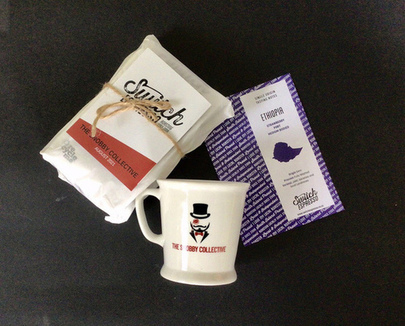August 2021
Feature #34
Our second collaboration with Switch Espresso. We first got together with the Switch team way back before Covid became a reality of our daily lives, seems like so long ago and its a pleasure to present a follow up collaboraation as we really enjoyed the story of Tolima, Colombia and the work of ASOPEP. While we can't offer you a cup to help you reminiss our 6th installment of Colombia, you can enjoy the story here.
QOREE STATION:
Located in the highlands of the Oromia region is the Woreda (district) of Gera, named after the kingdom of Gera
(1835-1887) it is home of the Qoree station. The surrounding Woreda of Gera area enjoys cooler and
wetter conditions than other areas of Djimma, this combined with more shade cover provides favourable conditions for
sweet and flavourful coffees.Cherry processed at Qoree station is grown at local farms, which are typically less than 1 hectare and semi shade grown. These plots are often known as garden coffees due to their
size and intercropped with other cash crops to maximise their returns. It is commonplace for most small lot holders
to cultivate using traditional, entirely manual methods.In line with the traditional approach, most coffee in Ethiopia
is also grown with no chemical fertiliser or pesticide used.
Meticulously hand picked and delivered to the station, the coffee cherry is then floated to remove underripes
and visually inspected to eliminate defects. After flotation and sorting, the cherry is mechanically de-
pulped using the stations disc pulper before being wet fermented for 18-24 hours. After fermenting, parchment
is washed in fresh water and moved to raised beds to dry. During the 14-18 day drying process, parchment is regularly
turned to ensure even drying, while turning the beans, workers pick over the parchment to remove any damaged beans.
JARC AND LANDRACE VARIETIES:
While widely being regarded as the home of coffee is quite the accolade, Ethiopia offers much more than just kudos.
It offers diversity in what is commonly referred to as Heirloom, JARC or landrace varieties. Untold amounts (estimated 10-15,000) of native varieties that have adapted over time to the microclimate in which they grow. While a considerable number of these varieties have been domesticated for cultivation, many can still be found growing wild and their genetics not formally identified. These varieties, while genetically different take considerable time and skill to differentiate between, an almost impossible proposition on a large scale especially as they are often growing in close proximity to each other. The result is when picked, the cherries are bulked together with no distinction between
individual varieties.
These varieties typically offer high cup quality with low yield. One of the other significant challenges with landrace varieties is that due to their regional specific needs, they’re incredibly hard to grow en mass or cultivate in other areas of Ethiopia (or the world). JARC varieties are different, researched developed and for their favourable characteristics (disease resistance, cup quality, yield etc) by Jimma Agricultural Research Centre (JARC).
Such characteristics and requirements result in the diverse and distinctive flavour profiles found in the growing regions of Ethiopian coffee.
JARC varieties differ from their landrace counterparts, having been researched and developed for their favourable
characteristics (disease resistance, cup quality, yield etc) by Jimma Agricultural Research Centre (JARC).
JEBENA BUNA:
Buna Tetu, Meaning “come drink coffee” in Amharic, the holy language of the Ethiopian Orthodox church. Coffee in its native homeland is steeped in tradition, it is part of the fabric of daily life and community. Coffee consumption dates back ten centuries in Ethiopia, with the local population consuming approximately half their annual harvest domestically. At this point it is worth noting that it is prohibited to consume export quality coffee domestic. The traditional coffee ceremony Jebena Buna, is a hospitable act. A sign of respect and welcoming to new acquaintances, it is always orchestrated by women. Beginning with handle - less cups being laid on the table along side traditional snacks, freshly cut grass is displayed on the floor while incense burns. Coffee beans are washed freshly before being roasted over an open flame in a flat bottom pan, known as a Mitad. The roast profile is dark, very dark to the point of black and charred. The freshly roasted beans are then ground using a mortal and pestle and added to the Jebena, a special spouted jug, which is filled with boiling water. The Jebena is then returned to the fire to brew the coffee. Once brewed, the thick potent coffee is poured to the brim, but never beyond. This first round, called Arbol is the strongest. Using the same beans, the Jebena is again filled with water for two more rounds of brewing. Tona, the second brew is mild, followed by Berekha. While the weakest in flavour, Berekha holds the most significance as a blessing. All in all the ceremony takes around an hour and is preformed 3 times a day.
TASTING NOTES:
Country: Ethiopia
Region: Djimma
District: Gera
Producer: Qoree Washing Station
Altitude: 1975 MASL
Varietal/Species: JARC varieties, Local Landraces
Process: Fully Washed
Average contributing farm: <1 hectare
Tasting notes: Strawberry, Port, Medium body
Click here for more about how coffee is traded in Ethiopia.
RECIPE:
Recommended method: Pour over
Brewer: V60
Ratio: 18G coffee 300G water
Method: 50 g bloom for 30 seconds
Pour remaining 250g water over 1 minute, aiming for total brew time of 3 – 3.30 minutes
|
© Copyright Derelict Coffee Roasters |

